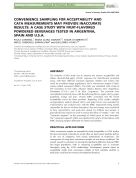Por favor, use este identificador para citar o enlazar este ítem:
https://repositorio.uca.edu.ar/handle/123456789/5422| Título: | Convenience sampling for acceptability and cata measurements may provide inaccurate results : a case study with fruit-flavored powdered beverages tested in Argentina, Spain and U.S.A. | Autor: | Cardinal, Paula Zamora, María Clara Chambers, Edgar Carbonell Barrachina, Ángel Hough, Guillermo |
Otros colaboradores: | Comisión de Investigaciones Científicas (Argentina) Universidad Católica Argentina. Facultad de Ciencias Agrarias Consejo Nacional de Investigaciones Científicas y Técnicas (Argentina) Kansas State University. Sensory Analysis Center La Universidad Miguel Hernández de Elche (España). Departamento Tecnologíıa Agroalimentaria. Grupo Calidad y Seguridad Alimentaria |
Palabras clave: | BEBIDAS; JUGOS; ACEPTABILIDAD; CONSUMIFORES | Fecha de publicación: | 2015 | Cita: | Cardinal, P., Zamora, M.C., Chambers, E., Carbonell Barrachina, A. y G. Hough. 2015. Convenience sampling for acceptability and cata measurements may provide inaccurate results : a case study with fruit-flavored powdered beverages tested in Argentina, Spain and U.S.A. [en línea]. Postprint del artículo publicado en Journal of Sensory Studies, 30(4). Disponible en: https://repositorio.uca.edu.ar/handle/123456789/5422 | Resumen: | Abstract: The objective of this study was to measure the sensory acceptability and obtain check-all-that-apply (CATA) responses for fruit-flavored powdered juices, with three different consumer segments: children and women who could be considered target populations, and a convenience sample of foodscience- related consumers (FSRC). The study was conducted with a total of 550 consumers in four cities: Alicante (Spain), Buenos Aires (Argentina), Manhattan (U.S.A.) and 9 de Julio (Argentina). The products were reconstituted powdered juices with the following flavors: apple, cherry, grape, grapefruit, orange and pear. Overall, FSRC consumers had the lowest acceptability scores for these products. Regarding CATA results, multiple correspondence analysis showed cherry and grape juices were associated to artificial-flavor and artificial-color, with the FSRC respondents being mainly responsible for the use of these descriptors. Pear and orange were considered to have natural-flavor and good-color, mainly by children and women. A generalized linear model was used to analyze the effect of “sample,” “city” and “consumer segment” on the percentage of checks given to each descriptor. The “consumer segment” effect was significant for nearly all descriptors, with FSRC checking samples differently to women and children | Cobertura Espacial: | ARGENTINA ESPAÑA ESTADOS UNIDOS |
URI: | https://repositorio.uca.edu.ar/handle/123456789/5422 | Disciplina: | INGENIERIA EN ALIMENTOS | Derechos: | Acceso Abierto | Fuente: | Posprint del artículo publicado en Journal of Sensory Studies 30(4), 2015 |
| Aparece en las colecciones: | Artículos |
Ficheros en este ítem:
| Fichero | Descripción | Tamaño | Formato | |
|---|---|---|---|---|
| convenience-sampling-acceptabiblity.pdf | 598,21 kB | Adobe PDF |  Visualizar/Abrir |
Visualizaciones de página(s)
177
comprobado en 30-abr-2024
Descarga(s)
730
comprobado en 30-abr-2024
Google ScholarTM
Ver en Google Scholar
Este ítem está sujeto a una Licencia Creative Commons

